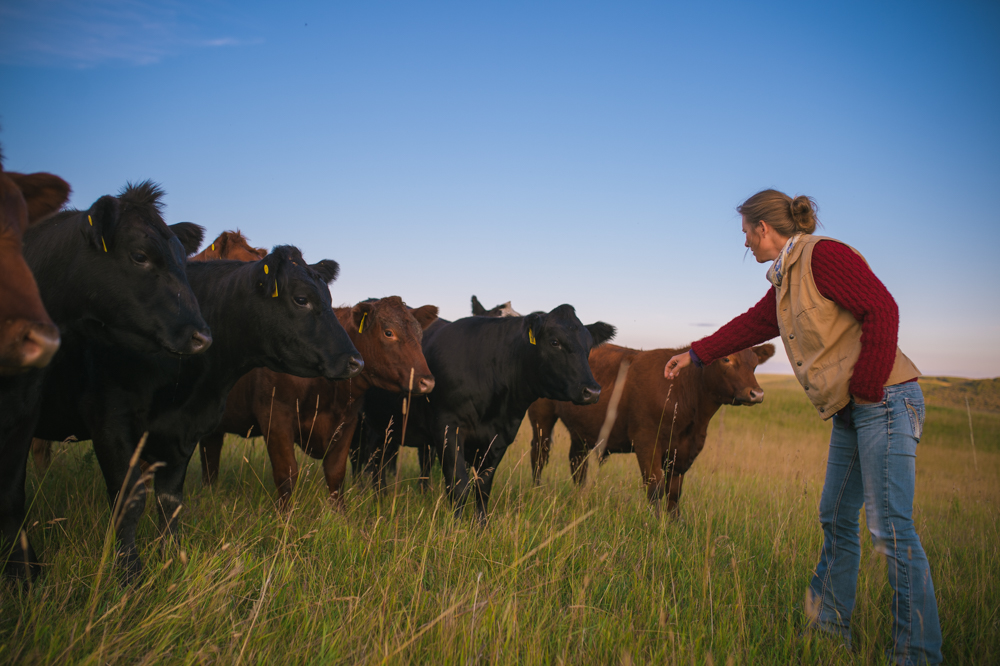The Herd
Our Grassfed and Grass-Finished beef cattle are naturally-raised from birth to harvest on our family ranch near Nanton, Alberta. They are born, raised, and finished on grass, just as nature intended. Respect for the land and animals is foremost in our operation. All of our management decisions are based upon ensuring the best possible life for our cattle. The herd is primarily made up of Red Angus and Black Angus cows and bulls, with some Hereford influence. These British breeds are noted for feisty calves, winter-hardy cattle, and the ability to thrive on a forage-based diet. These healthy, happy cows produce premium Grassfed Alberta Beef.

Our Best Practices
The herd is small and closely managed. Low-stress livestock handling, a method of working with cattle that recognizes their innate instincts, keeps our animals quiet and relaxed. Everything is done slowly. We use horses to assist with the cattle work. Moving fields, checking cows, cattle drives, and sorting are all done effectively and quietly thanks to our equine “colleagues.” Our cattle are also accustomed to being near people on foot. Keeping the herd gentle and trusting of humans ensures that their stress-levels remain low every time they are handled. This means that even their day at the butcher is a low-stress event. We have designed and built our ranch infrastructure–pens, sorting alleys, squeeze chute, and loading facility–to process cattle in the most humane manner.
Most significantly for their well-being, GRASS is what cattle are designed to eat. A steady diet of grass and other native and domestic forages keeps cattle healthy. Our calves are born on stockpiled grass in the spring and then turned out onto fresh green grass. During the the green and growing season, our cattle are rotationally-grazed using portable electric fences to ensure that they are always eating the highest quality grasses. The “Beef” herd is closely managed on prime pastures and spends everyday of their lives on grass. Our ranch consists of native shortgrass prairie, native fescue grassland in the hills, and a variety of domestic pastures. Grazing continues throughout the fall. During the winter the cattle have a steady diet of hay, while remaining out in the fields to forage.
Are cattle are 100% grassfed and grass-finished. Our cattle are never fed grain or artificial supplements. Cattle have complex ruminant digestion designed to efficiently process grass. Happy, healthy cattle live on grass!
Happy, healthy cattle are our top priority on the ranch. Our cattle receive no growth-hormones, or sub-therapeutic antibiotics. They lead a low-stress lifestyle, and because our cattle are born, raised, and live the way nature intended, free-range on grass– they are vital and healthy. We believe in adhering to the highest standards of animal husbandry. This means that if an animal does get sick or injured we will attend to it to provide comfort, pain relief, and facilitate healing. If an infection needs to be treated we make discretionary use of antibiotics. Stringent record keeping documents our herd health practices. We comply with all safety measures for antibiotic use and follow a strict withdrawal period that ensures antibiotics never enter the food chain. Our management practices exceed industry standards. We do not make the claim that our beef is “antibiotic free,” because we believe that it is in our animals’ best interests to receive veterinary attention and remain in our program in their familiar herd, rather than being treated and sent through auction into the conventional system. You can be assured that our cattle will never be mass-treated with antibiotics or receive sub-therapeutic treatment.
Vaccines are an important part of herd health. Our calves are inoculated before they are turned out with their mothers on pasture in the summer and receive a booster at weaning time in the fall. We vaccinate against diseases that are common in our region and pose a serious health threat to our cattle, such as pneumonia and black leg. Much like early childhood vaccines, these are all traditionally-formulated vaccines and our protocols are monitored by our local veterinarian. There are currently no mRNA vaccines approved for use in animal health. Please visit us to learn more about our practices and to see what cattle look like at home on the ranch.

content cattle

The Pairs
We select for quiet mothers and bright calves who grow up to be beefy. The calves are born in the spring as the grass freshens, spend the summer on pasture, and are weaned in the late fall, using fence-line weaning to be low stress for both the cows and calves.

The Yearlings
After weaning, at about 7 months old, the babies turn into “kid calves,” as our children call them. At this age cattle are curious, sociable, and some of them turn into real characters as they go through the growth spurts of adolescence.

The Beef
Destined for butchering at 26-29 months of age, these large, mature cattle live a full season longer than conventional beef cattle. They spend every day of their lives free-range in a familiar herd with all the comforts of fresh air, clean water, forage, and shelter, just as nature intended.
